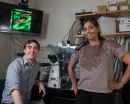(Press-News.org) CHAMPAIGN, Ill. — By simply carrying around their cellphones, patients who suffer from chronic disease could soon have an accurate health monitor that warns their doctors when their symptoms worsen.
GaitTrack, an app developed by researchers at the University of Illinois at Urbana-Champaign and the U. of I. at Chicago, turns a smartphone into a sophisticated medical device. Unlike other apps that merely count steps, GaitTrack uses eight motion parameters to perform a detailed analysis of a person's gait, or walking pattern, which can tell physicians much about a patient's cardiopulmonary, muscular and neurological health.
Led by Bruce Schatz, the head of medical information science and a professor of computer science at the U. of I., the team published its findings in the journal Telemedicine and e-Health.
"Fitness apps and devices are tuned for healthy people," said Schatz, who also is affiliated with the Institute for Genomic Biology at the U. of I. "They cannot accurately measure patients with chronic disease, who are the biggest medical market. A pedometer is not a medical device. But a cheap phone with GaitTrack software is."
According to Schatz, gait is sometimes called the "sixth vital sign" – after temperature, blood pressure, heart rate, respiratory rate and blood oxygen level. Gait speed involves several systems of the body working together in coordination, so changes in gait can be a sign of trouble in one or more systems.
Doctors often use an assessment called the six-minute walk test for patients with heart and lung disease, such as congestive heart failure, chronic obstructive pulmonary disease (COPD) and asthma. Patients with chronic disease often cannot be measured with typical pedometers since they tend to walk with shorter, more careful strides, or to shuffle, so specialized medical accelerometers are used.
The Illinois team used GaitTrack to administer six-minute walk tests to 30 patients with chronic lung disease and found that it monitored more accurately – and more cheaply – than the medical accelerometers. In addition, they discovered that analysis of the gait data could predict lung function with 90 percent accuracy, within an age group.
"The original plan was just to validate the software against the standard medical walk test," Schatz said, "but we looked at other data and found that it matched well with a pulmonary function test called FEV1. Predicting FEV1 is useful because that's the standard number used to determine treatment. That's worth a lot to a health system."
Schatz envisions the GaitTrack app running constantly in the background as a patient carries a phone. The phone would periodically collect data, analyze it and keep tabs on the patient's status, alerting the patient or patient's doctor when it detects changes in gait that would indicate a decline in health so that treatment could be adjusted responsively.
The researchers now are testing GaitTrack in larger trials within health systems. Schatz hopes to have the app available for download within months.
"Population health measurement is the key to making health care viable. If you could just measure what people were doing all the time, then you could get enough information to make rational decisions," Schatz said.
INFORMATION:
The U.S. Department of Agriculture supported this work in part. Schatz will present this work at the annual meeting of the American Telemedicine Association this month.
Editor's note: To reach Bruce Schatz, call 217-244-0651; email schatz@illinois.edu.
The paper, "Health Monitors for Chronic Disease by Gait Analysis With Mobile Phones," is available online at http://online.liebertpub.com/doi/full/10.1089/tmj.2014.0025.
GaitTrack app makes cellphone a medical monitor for heart and lung patients
2014-05-08
ELSE PRESS RELEASES FROM THIS DATE:
Tackling test anxiety may help prevent more severe problems
2014-05-08
Showing students how to cope with test anxiety might also help them to handle their built-up angst and fretfulness about other issues. The results of a new study by Carl Weems of the University of New Orleans show that anxiety intervention programs that focus on academic matters fit well into the demands of the school routine, and do not carry the same stigma among youth as general anxiety programs do. The research group was among the first to study the effects of Hurricane Katrina on community mental health and anxiety among youths, and the paper appears in Prevention ...
Ovarian cancer cells are more aggressive on soft tissues
2014-05-08
When ovarian cancer spreads from the ovaries it almost always does so to a layer of fatty tissue that lines the gut. A new study has found that ovarian cancer cells are more aggressive on these soft tissues due to the mechanical properties of this environment. The finding is contrary to what is seen with other malignant cancer cells that seem to prefer stiffer tissues.
"What we found is that there are some cancer cells that respond to softness as opposed to stiffness," said Michelle Dawson, an assistant professor in the School of Chemical and Biomolecular Engineering ...
Army drug users twice as likely to use synthetic marijuana as regular marijuana
2014-05-08
Social work researchers from the University of Washington have found that among a group of active-duty Army personnel who use illicit drugs, the most abused substance is synthetic marijuana, which is harder to detect than other drugs through standard drug tests.
The research will be published in the July 2014 issue of Addictive Behaviors, but is already online.
Synthetic marijuana, sometimes called "Spice," is made with shredded plant material coated with chemicals that are designed to mimic THC, the psychoactive compound found naturally in marijuana. The U.S. Drug ...
Single cell genome sequencing of malaria parasites
2014-05-08
SAN ANTONIO, May 8, 2014 – A new method for isolating and genome sequencing an individual malaria parasite cell has been developed by Texas Biomed researchers and their colleagues. This advance will allow scientists to improve their ability to identify the multiple types of malaria parasites infecting patients and lead to ways to best design drugs and vaccines to tackle this major global killer. Malaria remains the world's deadliest parasitic disease, killing 655,000 people in 2010.
Malaria parasite infections are complex and often contain multiple different parasite genotypes ...
New genomics technique could improve treatment and control of Malaria
2014-05-08
Single-cell genomics could provide new insight into the biology of Malaria parasites, including their virulence and levels of drug resistance, to ultimately improve treatment and control of the disease, according to new research funded by the Wellcome Trust and the National Institutes of Health.
The findings are revealed in a study by researchers at the Texas Biomedical Research Institute and published today in the journal Genome Research.
Malaria infections commonly contain complex mixtures of Plasmodium parasites which cause the disease. These mixtures, known as multiple ...
Open science journal publishes attempt to reproduce high-profile stem cell acid bath study
2014-05-08
In a study published today in F1000Research, Professor Kenneth Lee of the Chinese University of Hong Kong reveals the full experimental results of an attempt to replicate a controversial study published in Nature recently that suggested that bathing somatic cells in acid can reprogram them to induced pluripotent stem cells (iPS cells). With systematically collected and fully available data, Lee and his colleagues report that carefully replicating the original acid-treatment method does not induce pluripotency in two types of mouse somatic cells, including those used in ...
NASA sees system 90E moving toward southwestern Mexico
2014-05-08
A tropical low pressure area known as System 90E is located a couple of hundred miles southwest of Zihuatenejo, Mexico today and was seen by NASA's Terra satellite on its way to a landfall.
The Moderate Resolution Imaging Spectroradiometer (MODIS) instrument aboard NASA's Terra satellite captured a visible image of System 90E on May 7 at 18:50 UTC/ 2:50 p.m. EDT as it headed to a landfall in southwestern Mexico. The low appeared disorganized as it approached the southwestern coast of Mexico near the states of Michoacan and Guerrero.
According to NOAA's National Hurricane ...
Recycling a patient's lost blood during surgery better than using banked blood
2014-05-08
Patients whose own red blood cells are recycled and given back to them during heart surgery have healthier blood cells better able to carry oxygen where it is most needed compared to those who get transfusions of blood stored in a blood bank, according to results of a small study at Johns Hopkins.
In a report for the June issue of the journal Anesthesia & Analgesia, the researchers say they found that the more units of banked blood a patient received, the more red cell damage they observed. The damage renders the cells less flexible and less able to squeeze through a ...
Few women at high-risk for hereditary breast and ovarian cancer receive genetic counseling
2014-05-08
Mutations in the BRCA1 and BRCA2 genes account for nearly 25 percent of hereditary breast cancers and most hereditary ovarian cancers, yet a study by cancer prevention and control researchers at Virginia Commonwealth University Massey Cancer Center suggests an alarmingly small amount of women who qualify for BRCA genetic counseling actually receive the services. Additionally, they found that a significant proportion of women with a family history of breast and ovarian cancer underestimate their own risk.
The study, published in the April edition of the Journal of Community ...
Anti-aging factor offers brain boost too
2014-05-08
A variant of the gene KLOTHO is known for its anti-aging effects in people fortunate enough to carry one copy. Now researchers find that it also has benefits when it comes to brain function. The variant appears to lend beneficial cognitive effects by increasing overall levels of klotho in the bloodstream and brain.
What's more, the improvements in learning and memory associated with klotho elevation aren't strictly tied to aging. They do occur in aging mice, but also in young animals, according to a report published in the Cell Press journal Cell Reports on May 8th. ...


